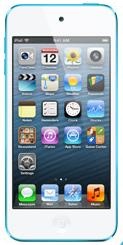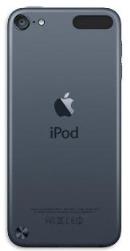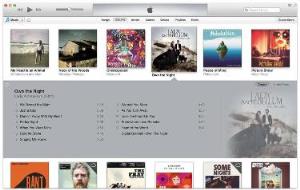
Yes, Virginia, there still is an iPod Touch
At first glance, it might seem that the iPod touch today is an orphan. It's like an iPhone, but doesn't have a phone. It's like a iPad, but doesn't have that large display. However, it not only still exists, Apple has just given it a major upgrade.
Last things first. Usually, I hold overall opinions for the end. But given such similar, overlapping devices, the most prominent question is "Is it even worth getting an iPod touch anymore, amid such encompassing siblings?" and that question should be addressed upfront.
If you have an iPhone -- or perhaps any Smartphone -- no, you don't need an iPod touch. There's too much overlap. If you have an iPad, or some other tablet -- well, the question gets trickier. You probably have little need for the iPod touch -- though many people use their large tablets exclusively at home. In that case, an iPod touch slips into any pocket easily, so, it might have value in that case -- depending on your usage.
Where the iPod touch shows its greatest value is if you have a basic cell phone. There is a large world that wants a phone to be a phone. Period. Just make a call and receive them. No camera, no music, no Internet and email, no photos, no games, no nothing. Just -- a -- phone. And in that world, there is still a big place for an iPod touch as a companion device.
Particularly if you fit in that universe (and it's a large one), read on. Because the iPod touch is an impressive device...
APPLE iPOD TOUCH 5th GENERATION
I acknowledge upfront that I've never been one to advocate upgrading your tech products just because the latest version is now available. My philosophy has long been -- if your device works and does what you want it to, don't screw around with it. If an upgrade offers new features that are actually important to you and that you will actually use regularly, that's when it's time to dive back into the pool. (That well might be every time a new version is released, but it's not because the version is simply new and the latest, but because it's better for your purposes.)
I last reviewed the iPod long ago -- the third generation. In fairness, the 4th gen product was worth taking a look at, but I didn't. Life goes on. So, this here will be as much a review of the new iPod touch 5th Gen on its own merits as it is a comparison leapfrogging a generation.

At this point in life, there isn't a great need to describe in detail what an iPod touch-like device does. In short, it's an MP3 music player on steroids. You can connect to the Internet, get emails, watch videos, play games, display photos, and solve world peace. It's Bluetooth-enabled, so you have access to a compatible devices. What matters most, though, are the changes.
What's most notable is that the iPod touch is taller, thinner and lighter than its predecessor. Impressively so -- it fits almost-unnoticeably in a shirt pocket. And being taller, it plays widescreen movies better than before, when turned in horizontal mode. (For those with a ruler handy, it's 4.86 × 2.31 × 0.24 inches. And weighs 3.1 ounces.)

Also notable is the new Lightning connector plug, which has perhaps gotten the most notoriety among all of Apple's new handheld devices. Rather than the old 30-pin connector, this is a single, tiny plug. There's good and bad -- the good is that this allows for the iPod to be as thin as it is. It's nice, too, that you can plug it in from any direction, though I don't find that as critical as some people do. It was never problematic plugging the old cord in. The bad is that...well, none of your old connectors will work. To help, Apple sells an adapter plug, though a) it's not elegant, and Apple design has always been about elegance, b) it may not work for all your devices, and c) you may need several, and they're each $29. Many people won't have any need for an adapter. Many will. But that's life in the big city. Lightning is a very good connector, but some people will be unhappy in the short run.

The new touch has a dual-core A5 chip. This is meaningless techie for most, but the short version is that the device is very fast. It has twice the processing power and a seven-times faster graphics display than before. Yet impressively, even while more powerful, it has the same battery specs: up to 40 hours of music or 8 hours of video on a single charge.
(As for that battery, it will be fully charged in 4 hours, but with its "fast charge," you'll get 80% in a zippy two hours.)
Apple has also made a big deal about the new earphones (called EarPods), and how they spent three years developing them. They have a bit better fit, and nicer sound. But a major flaw to me is that the mini-remote control on the cord is now gone. As such, I find myself using the old earphones, so that I can pause, fast forward and adjust the volume with them.
There is a wrist strap, called "The loop" which Apple has also made a big deal about, how you can hook it over your wrist and...well, okay. Fine. It's borderline meaningless to me. I don't want an iPod dangling from my wrist, nor have a strap dangling from my iPod. You might, fair enough. It's optional if you want to install it, or not.
There are also quite a few improvements over the touch 4th Generation. (And many improvements for those making the leap from the 3rd Gen.)
Though the Retina screen existed previously, it's now bigger, at 4 inches. The image quality and colors are wonderful - vibrant and rich (most particularly if you hadn't upgraded to the 4th Gen yet; the screen will jump out at you). The larger widescreen makes it notably more pleasurable for watching movies and videos. The screen, of course, is still much too small to really appreciate any video properly, but for something this small, the clarity helps immeasurably.
The iSight camera has been improved, as well, and is now 5 megapixels, which is seven times previous generation. It also takes video in 1080p HD. The pictures it takes are very crisp, and it does quite a good job with video. A respectable standalone camera will offer more, but for quick, handy usage, this is impressive. It's likely the biggest addition for those coming from the iPod touch 3G, which didn't have a camera. While an improvement over the 4G, I don't find it as big a jump - 5 megapixels is great, but for most people you have little need for that, unless you plan to print big enlargements.

With a few helpful photo apps, you can "edit and crop and enhance" your picture in camera. Tap to focus and face detection are good touches. And also very interesting is that the camera can take shots in Panorama Mode, a new process that allows for wiiiiiiide screen photographs. Oddly enough, this feature isn't yet available in iPads, because it requires an A5 processor.
The highly-promoted Siri feature is also available. It's not something I find myself using a great deal - but for those who do want it, Siri works extremely well. (The main reason I personally use Siri less is that your iPod has to be connected to WiFi, and if you keep WiFi disabled or there's no WiFi available, you're out of luck.) Basically, it's like an audio assistant. You can use voice commands to open apps, answer questions you'd otherwise use a search engine for, dictate and send emails, schedule reminders and more. It does a very good job. But again, you need a WiFi connection.
The iCloud feature came to Apple handhelds with the iOS 6 operating system -- it syncs data to the "cloud" and makes your content available across all your devices. Two things to keep in mind about iCloud -- it works very effectively with Apple products, though not as well with PCs and Outlook. Also, like Siri, it requires WiFi, so if you're out of range and want to access your iCloud data, you can't.
By the way, at the very beginning, I mentioned that the biggest difference between an iPod touch and iPhone is that with the latter you can make phone calls. This is true -- but with a twist. Because you actually can make calls with an iPod touch. Once again, you need to be connected to WiFi, but when you are, the FaceTime feature lets you make a call to anyone else who also has FaceTime on their Apple device.

Somewhat similarly, the iMessage app lets you send instant messages without needing a phone. But...well, okay, you know the drill by now. You need to be connected to WiFi. But both of these features (Facetime and iMessage) really expand the capabilities of an iPod touch and make it border on the edges of phone capability.
Ultimately, there is a wide range of features that could go on being mentioned endlessly. Some are part of the iPod touch itself, some come with the iOS 6 operating system. Among the more noteworthy are:
WiFi Sync, which allows you to directly integrate with Facebook and Twitter for posting photos and updating information on the sites.

AirPlay lets you wirelessly stream video on on your iPod touch to your high-def television, though it requires Apple TV. (The AirPlay Mirroring feature displays what's on your iPod's screen - not just streaming, but it will show webpages, photo and games.)
Dictation is a terrific iOS 6 feature, particularly on a device like the iPod touch where the small keyboard makes effective typing a challenge. When you bring up the on-screen keyboard, you just tap the microphone icon at the bottom and talk. Tap "Done," and everything is converted to text. This can be used for writing emails, taking notes, and searching the Internet, wherever you'd use a keyboard.
I won't get much into the basics of listening to music, but the core of the iPod touch is still its capability as a music player, and it does that wonderfully. I have some quibbles about how it organizes music sometimes and also doesn't let you adapt it to your personal preferences, but overall music and podcasts are organized well, and access to them is very easy. And the massive world of iPod apps is now near-legendary. Know, however, that despite reading about many hundreds of thousands of apps, you'll likely only download between 20-50, and end up using eight of them regularly. Still, the choices are vast and strong.
You sync your material through your computer using iTunes, which is separate discussion entirely. It's worth adding here, though, that you can now sync wirelessly, which can be valuable depending on your situation. Personally, I still like syncing with the included cable. I find it simpler to just plug in. As for iTunes itself, it has its defender and haters, all centered on how proprietary Apples has made the program. The short version is that this makes for easy use, but it's not overly flexible. Apple has released version 11, which has some interesting new features and an improved interface, though some important old features have been dropped, most notably a List View for displaying albums. Enough complaints have been lodged online that it will be worth watching to see if it eventually returns. Add my voice as one of the complaints.

The new iPod touch 5G is a wonderful and wildly-versatile device. It doesn't come cheaply. The 32 GB model is $299, and the 64 GB sells for $399. (The low-end 16 GB version has been phased out.) So, is it worth it.
First, the upgrade question. If you currently own the previous 4th Generation touch, the new features and improvements are excellent, though I don't think they're compelling enough to make this a Must Upgrade. However, if you are one of those who absolutely needs have the latest, you'll definitely appreciate the changes. These aren't surface tweaks. It's significantly thinner, taller, lighter, faster with a bigger display, and a better experience. But the previous touch was so good. It's the hurdle of increased excellence.
On the other hand, if you haven't upgraded for a while and are considering a new iPod touch, the changes since you last bought a touch almost make this a no-brainer. The camera alone is worth it, and there's so much more. If you do upgrade, I suspect you'll be extremely happy.
That leaves those brand new customers. Those who are basic cell phone kind o' people and only want a basic cell phone that makes calls, period -- but now have decided they want the ability to take photos, get email, play music and games, and much more. The question isn't quality and features, but comes down to value, and that's personal. Because make no mistake, the iPod touch is a remarkable, portable device that still has a place in the tech world. Even if that place is smaller than it once was.
*
To read more from Robert J. Elisberg about other matters from politics, entertainment, technology, humor, sports, and a few things in between, visit Elisberg Industries.
